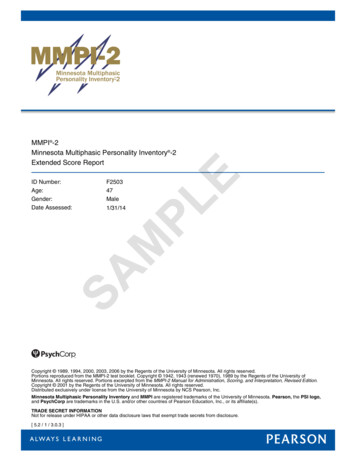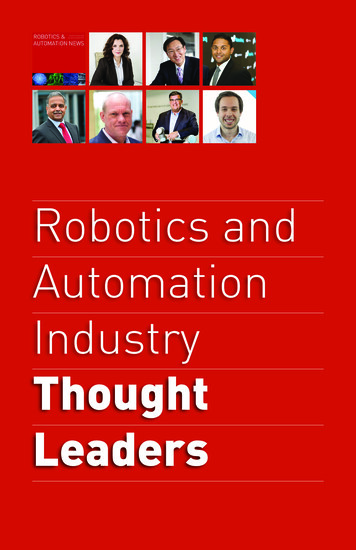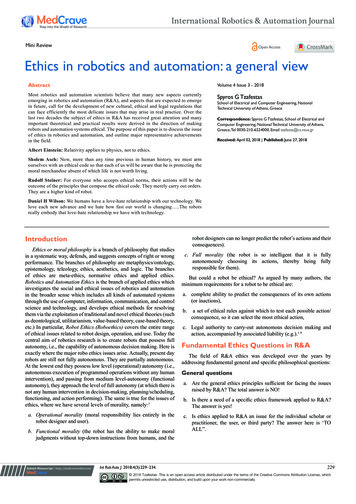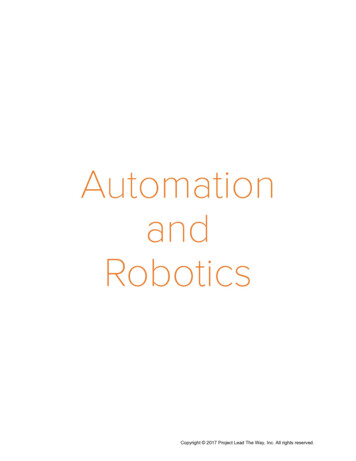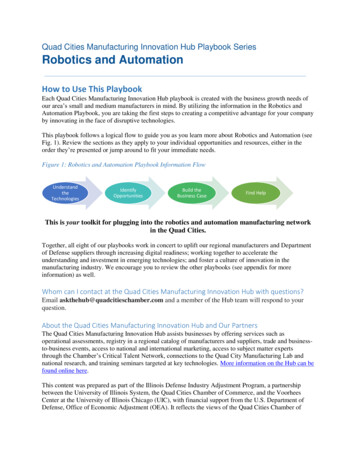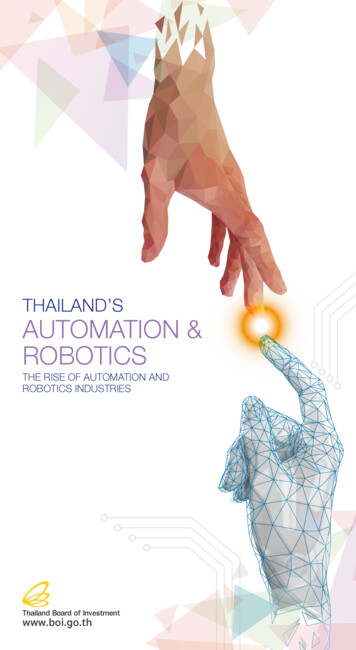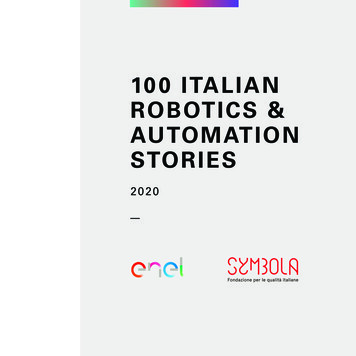
Transcription
10 0 ITALIANROBOTICS &AUTOMATIONSTORIES2020
K EYIMP R E SEC O MPA NIESCE NT RI D I RICE RCA /IST RUZ IONERESE A RCH CE NT E RS /E D UCAT IONL E GE NDAT E RZ O SE TTORE /AGE NZ IE P UBBLICH ET H IRD SE CTOR /P UBLIC AGE NCIE SA ERO S PA ZI O.A ER O S PAC EAG R I C O LTU R A.AG R I C U LTU R EAU TO M A ZI O N E.AU TO M ATI O NAU TO MOT I VE.AU TO MOT I V ED I V U L G A ZI O N E.D I S S EM I N ATI O ND O M OTI C A.D O M OTI C SED U TA I N M EN T E S PO RT.ED U TA I N M ENT & S PO RTLO G I ST I C A.LO GI ST I C SN U RS I N G / AS S I STEN ZA.NURSING/CARER I C ERC A.R ES EA R C HS A L U TE.H EA LTHS I CU R E Z Z A.S EC U R I T Y
PREF ACE“We can only see ashort distance ahead,but we can see plentythere that needsto be done.”A.M. TuringLast March, in the municipality of Peccioli in Tuscany, the first roboticshopping carts were taken into service. The carts go straight to theshops’ entrances and then reach autonomously the houses of the peoplewho made the purchases. In May, at the Gran Caffè di Rapallo, whichHemingway was known to frequent, the first two robotic waiters inLiguria and Italy were officially put into service. While in Ravello, duringthe summer, a robot took turns with Maestro Massimiliano Carlini inconducting the Instrumental Ensemble of the historic Salerno StateConservatoire ‘Giuseppe Martucci’.Robots and automatons become part of everyday life, more and morepresent in housework, recreation or care. Their presence is alreadya consolidated reality in many contexts, as in that of surgical robotsthat improve the quality of procedures, helping patients to recovermore quickly. In Italy, robotic surgery is already used in thousands ofprocedures per year. The automatic carts for the transport of goodsand food, active 24 hours a day, every day, in many hospitals, logisticscentres and in industry, are a further proof.Worldwide, the robot market has reached a value of 16.5 billion dollars;in 2018 alone, 422,000 robots were shipped worldwide, with a 6%increase compared to the previous year.The Italian industry ranks sixth in the world in terms of total stock ofinstalled industrial robots (69,142 units in 2018)1 , with China, Japan,South Korea, United States and Germany ahead. The 2015-2017 periodhas seen an increased use of robots, also due to the super-amortisation14IFR, World Robotics 2019P R E FA ZIONE“Possiamo vederenel futuro solo perun piccolo tratto,ma possiamo purevedere che in questopiccolo tratto c’èmolto da fare.”A.M. TuringLo scorso marzo nel comune di Peccioli in Toscana hanno preso servizio iprimi carrelli della spesa robotici, che arrivano direttamente all’ingressodei negozi per poi raggiungere in maniera autonoma le case dei cittadiniche hanno fatto acquisti. A maggio presso il Gran Caffè di Rapallo, dovespesso si fermava Hemingway, sono ufficialmente entrati in servizioi primi due camerieri robot della Liguria e d’Italia. Mentre a Ravello,durante l’estate, un robot si è alternato con il Maestro MassimilianoCarlini nella direzione dell’Ensemble Strumentale dello storicoConservatorio “Giuseppe Martucci” di Salerno.Robot e automi entrano nella vita di tutti i giorni, sempre più presentinelle attività di pulizia domestica, in quelle ludiche o nei servizi diassistenza. In molti contesti la loro presenza è già una realtà consolidata,come nel caso dei robot chirurgici che permettono di migliorare laqualità degli interventi, favorendo una ripresa più rapida dei pazienti:in Italia la chirurgia robotica è già utilizzata in migliaia e migliaia diinterventi all’anno. I carrelli automatici per il trasporto di merci e vivande,attivi 24 ore al giorno, tutti i giorni, in molti ospedali, centri logistici enell’industria, sono un’altra conferma.A livello mondiale il mercato dei robot ha raggiunto il valore di 16,5miliardi di dollari, solo nel 2018 sono state consegnate 422.000 unitàin tutto il mondo, con un aumento del 6% rispetto all’anno precedente.L’industria italiana è sesta a livello mondiale per stock complessivo dirobot industriali installati (69.142 unità nel 2018)1, preceduta soltanto daCina, Giappone, Corea del Sud, Stati Uniti e Germania. Una presenza1IFR, World Robotics 20195
PREFACEPREFAZIONEincentives on the purchase of new machinery: 48% in food; 27% infashion; 21% in wood-furniture; 23% in metalworking2 . In production,the Italian robotics supply chain counts 104,000 companies, which havegrown by 10% in five years, employing a total of 429,000 people ( 17%in five years). The first province is Milan with about 12,000 companiesand 110,000 employees; then Rome with 11,000 companies and 63,000employees; followed by Naples with 5,000 companies and 13,000employees, and Turin with 5,000 companies and 25,000 employees.Brescia, Padua, Bari, Bologna, Florence, Monza and Brianza, Bergamoand Salerno3follow with about 2,000 companies. There are realities suchas that of the packaging valley, which boasts the highest concentrationof manufacturers of packaging machines, with a total turnover of 7,6billion euros in 20184 (1,5 billion of which from IMA – Industrie MacchineAutomatiche – alone).The 100 Innovation Stories Report, promoted by Enel and SymbolaFoundation in cooperation with UCIMU Foundation, is now in its fourthedition, after having studied innovation in the renewable energy,circular economy and e-mobility supply chains, delves into roboticsand automation, another sector of national excellence, deeply rootedin our country. Five hundred years ago the first project in history for ahumanoid robot, designed by Leonardo Da Vinci, was completed. Hismechanical knight, which we do not know as to whether it was evermade, must have been composed of a series of cogs that Leonardopinned down on various pages, some of which were, and still are, toFondazione Symbola – Unioncamere – Fondazione Edison, I.T.A.L.I.A. - 2019 Report,elaboration by Fondazione Edison based on International Federation of Robotics data.3Data source: elaboration of the Milan Chamber of Commerce Monza Brianza Lodi4Data source: Ucima26in forte crescita nel triennio 2015-2017, anche grazie agli incentividel superammortamento sull’acquisto di nuovi macchinari: 48%nell’alimentare; 27% nella moda; 21% nel legno-arredo; 23% nellametalmeccanica2 . Mentre nella produzione, la filiera della roboticaitaliana conta ben 104 mila imprese, cresciute del 10% in cinque anni,con un totale di 429 mila addetti ( 17% in cinque anni). Prima provinciaè Milano con circa 12 mila imprese e 110 mila addetti, poi Roma con11 mila imprese e 63 mila addetti, Napoli con 5 mila imprese e 13 milaaddetti, Torino con 5 mila imprese e 25 mila addetti. Seguono con circa 2mila imprese Brescia, Padova, Bari, Bologna, Firenze, Monza e Brianza,Bergamo e Salerno3 . In questa filiera troviamo realtà produttive comequella della packaging valley in cui si rileva la più alta concentrazioneal mondo di costruttori di macchine per il packaging, per un valorecomplessivo dei fatturati pari a 7,6 miliardi di euro nel 20184 (di cui circa1,5 dalla sola IMA – Industrie Macchine Automatiche).Il presente Rapporto 100 innovation stories promosso da Enel eFondazione Symbola, in collaborazione con Fondazione UCIMU, arrivatoalla sua quarta edizione dopo aver indagato l’innovazione nelle filieredelle energie rinnovabili, dell’economia circolare e dell’e-mobility,approfondisce la conoscenza di un comparto di eccellenza nazionale,quello della robotica e dell’automazione. Un settore che ha nel nostroPaese radici antiche. Basti pensare che il primo progetto completo per unrobot umanoide fu disegnato cinquecento anni fa da Leonardo Da Vinci. Ilsuo cavaliere meccanico, che non sappiamo se fu mai realizzato, dovevaFondazione Symbola – Unioncamere – Fondazione Edison, I.T.A.L.I.A. - Rapporto 2019,elaborazione Fondazione Edison su dati International Federation of Robotics3Fonte dati elaborazione della Camera di Commercio di Milano Monza Brianza Lodi4Fonte dati Ucima27
PREFACEPREFAZIONEunderstand. Leonardo’s mechanical knight could probably move its arms,looking like an armoured soldier. Later on, during the 18th century, otherinventors worked on automatons or self-propelled mechanisms. At thetime, it was more about machines made to entertain and impress theobserver; it had nothing to do with the robots that in the middle of lastcentury began to populate the factories. Franco Sartorio, an Italian, wasbehind the birth of mechatronics. He was a pioneer of the combinationof mechanics and electronics and in the 1960s he founded the DigitalElectronic Automation (DEA) in Moncalieri (TO), where the MeasuringMachine was produced; a device for dimensional measurements that“conquered” the world. Robots appeared in the Italian industry in the1970s, when Fiat introduced Robogate to its plants: a robotic system forassembling car bodies, developed by the Turin-based COMAU, one of themost famous robotics companies in the world. SIRI, the Italian Roboticsand Automation Association, the second association in the world in orderof time (the first one was in Japan), was founded in Italy in 1975, twelveyears before the foundation of the international federation.The excellence of Italian scientific research in the field of roboticsis recognised throughout the world, albeit too little in Italy. In 2015,Barbara Mazzolai and Cecilia Laschi, two of the world’s leading expertsin robotics, were included in the ranking of “25 women in robotics youneed to know about” by RoboHub, the largest international scientificcommunity. Both of these women were inspired by nature in creatinginnovative robots. Barbara Mazzolai, director of the Center for MicroBioRobotics of the Italian Institute of Technology (IIT) in Pontedera(PI), has created Plantoide, a robot that mimics the behavior of plants;Cecilia Laschi, Professor of Industrial Bioengineering at the BioroboticsInstitute of BioRobotics of the Sant’Anna School of Advanced Studies,8essere composto da una serie di ingranaggi che Leonardo appuntò invari fogli, a volte di difficile interpretazione. Probabilmente l’automapoteva muovere le braccia e aveva l’aspetto di un soldato con armatura.In seguito, nel corso del ‘700 altri inventori si ingegnarono per realizzareautomi o meccanismi semoventi. Si trattava di macchine realizzate perdivertire e stupire l’osservatore: niente a che vedere con i robot che ametà del secolo scorso hanno cominciato a popolare le fabbriche. A unitaliano, l’ing. Franco Sartorio, si deve la nascita della meccatronica.Pioniere dell’unione tra meccanica ed elettronica, negli anni ‘60 fondò laDea a Moncalieri (TO) da cui uscì la Macchina di misura: un dispositivoper misure dimensionali che conquistò il mondo. Nell’industria italiana, irobot fanno la loro comparsa in maniera considerevole intorno agli anniSettanta, quando la Fiat introdusse nei suoi stabilimenti Robogate: unsistema robotico per l’assemblaggio delle scocche delle auto, sviluppatodalla torinese COMAU, tra le più note aziende di robotica al mondo.Sempre in Italia, nel 1975, nacque SIRI, l’associazione dedicata allarobotica industriale, la seconda al mondo dopo quella giapponese, dodicianni prima che nascesse la federazione internazionale.L’eccellenza della nostra ricerca scientifica in campo robotico èriconosciuta in tutto il mondo, sebbene troppo poco in Italia. Sonoitaliane due tra le maggiori esperte al mondo di robotica, BarbaraMazzolai e Cecilia Laschi, inserite nel 2015 tra le 25 donne genialinella classifica stilata da RoboHub, la maggiore comunità scientificainternazionale formata da esperti in materia. Entrambe si sono ispiratealla natura per dare vita a robot innovativi: la prima, direttrice delCentro per la Micro-BioRobotica dell’Istituto Italiano di Tecnologia(IIT) a Pontedera (PI) ha ideato Plantoide, il robot che riproduce ilcomportamento delle piante; la seconda, Professore Ordinario di9
PREFACEPREFAZIONEis one of the pioneers of soft robotics, a branch of robotics dedicated tothe development of machines with soft and deformable surfaces, whichcreated the octopus robot that, with its dexterity, offers unprecedentedpossibilities of use. The European Commission recently chose the Pisabased institute as the head of the first EU network of laboratories entirelydedicated to this field. Italian robotics reaches also the infinite space:several technologies made in Italy were installed on the NASA InSightrobotic lander that touched down on Mars in 2018 and on those that in2020 will be used in the ExoMars mission to study the Martian soil, suchas the Larri (Laser Retro-Reflector for InSight) retroreflective semi-spherewhich will provide the position of the lander on Mars’ surface, developedby the National Institute for Nuclear Physics (INFN) with the support ofthe Italian Space Agency (ASI).However, robotics in Italy crosses the boundaries of research centresand businesses, becoming a culture and a widespread passion. Manyinstitutes teach robotics, not only on a theoretical level, enabling youngpeople to deal directly with programming of machines and to challengeeach other through competitions specifically designed for them, inwhich schools from all over the peninsula participate. The interest inthe field is so widespread among students that Italy is the only countryin the world to have its own national Zero Robotics Championship. Itis an international competition in aerospace robotics, which involvesthe programming and management of remote-controlled robotic minisatellites, assembled by MIT and located on board the InternationalSpace Station. The competition, which is internationally promoted byNASA, ESA, MIT and other important aerospace research centres, iscoordinated by Polytechnic University of Turin, ASI, University of Padua,Rete Robotica a Scuola and the Regional Scholastic Office of Piedmont.Not by chance, the 2018/2019 World Championship finals was won by two10Bioingegneria Industriale all’Istituto di BioRobotica della ScuolaUniversitaria Superiore Sant’Anna di Pisa, è tra i pionieri della roboticasoft, branca della robotica dedicata allo sviluppo di macchine consuperfici soffici e deformabili, creatrice del robot polpo che, con lasua destrezza, apre a inedite possibilità di utilizzo. Recentemente laCommissione Europea ha scelto proprio l’istituto di Pisa a capo del primonetwork UE di laboratori interamente dedicato a questa disciplina. Larobotica italiana arriva anche nello spazio: sono made in Italy diversetecnologie utilizzate sulla sonda robotica della Nasa InSight sbarcatasu Marte nel 2018 e su quelle che nel 2020 saranno utilizzate nellamissione ExoMars per lo studio del terreno marziano, come la semisferacatarifrangente Larri (Laser Retro-Reflector for InSight) che fornirà laposizione del lander sulla superficie di Marte, sviluppata dall’IstitutoNazionale di Fisica Nucleare (INFN) con il supporto dell’Agenzia SpazialeItaliana (ASI).Ma la robotica in Italia valica i confini dei centri di ricerca e delle imprese,diventando cultura e passione diffusa. Sono molti gli istituti in cui siinsegna robotica, non soltanto a livello teorico, consentendo ai ragazzi diconfrontarsi direttamente con la reale programmazione delle macchinee di sfidarsi attraverso competizioni loro dedicate, a cui partecipanoscuole da tutta la Penisola. L’interesse per la materia è così diffuso tragli studenti che l’Italia, unico Paese al mondo, ha un proprio campionatonazionale di Zero Robotics. Si tratta di una competizione internazionaledi robotica aerospaziale, che prevede la programmazione e la gestionedi minisatelliti robot comandati a distanza, realizzati dal MIT e collocati abordo della Stazione Spaziale Internazionale. La competizione, promossaa livello internazionale da NASA, ESA, MIT e altre importanti realtàdella ricerca aerospaziale, in Italia è coordinata da Politecnico di Torino,ASI, Università degli Studi di Padova, Rete Robotica a Scuola e Ufficio11
PREFACEPREFAZIONEItalian teams, the IIS Avogadro of Vercelli with its Liceo Scientifico andthe Liceo Scientifico F. Cecioni of Livorno, ranked respectively first andsecond in alliance with U.S. teams.Recently, the students of the Istituto di Istruzione Superiore FortunioLiceti in Rapallo were awarded a prestigious second place at the FirstGlobal Challenge of Robotics in Dubai.Italy has also proved to be ahead in the robotic design field, with the aimof improving the comfort of the interaction between robots and people,as in the case of the robotic hand - Hannes. The prosthesis was designedby Rehab Technologies IIT - Inail Lab of Genova in collaboration withdesigners Lorenzo De Bartolomeis, Gabriele Diamanti and Filippo Poli(ddp studio) and was awarded by the Association for Industrial Designwith the National Prize for Innovation “ADI Design Index 2018”.Moreover, the collaboration between the Higher Institute for ArtisticIndustries (ISIA) of Florence and the Sant’Anna School of AdvancedStudies in Pisa was created to develop projects in that direction. Designand ergonomics also come into play in the creation of exoskeletonsand other robotic devices that in the future will support human workby improving efficiency and reducing the risk of accidents and injuries,allowing workers to perform less risky activities being more focused onmanagement or product customisation.Robotics studies deal also with human and artificial intelligence and alsoin this field there is a strong commitment of our country, which has beenat the forefront for many years. In 2014, Italy hosted the first internationalconference on robotics (a term coined in 1942 by the scientist and sciencefiction writer Isaac Asimov) about the implications of the interactionbetween algorithms, robots and humans, and to promote and encouragethe development of robotics for the well-being of individuals and society12Scolastico Regionale per il Piemonte. Non è un caso che la finale delcampionato mondiale 2018/2019 sia stata vinta da squadre italiane, l’IISAvogadro di Vercelli con il suo Liceo Scientifico e il Liceo Scientifico F.Cecioni di Livorno, arrivate rispettivamente prima e seconda in alleanzacon squadre statunitensi. Recentemente gli studenti dell’Istituto diIstruzione Superiore Fortunio Liceti di Rapallo hanno invece raggiunto unprestigioso secondo posto al First Global Challenge di Robotica a Dubai.Altro tema sul quale l’Italia si è dimostrata avanti è quello del design, conl’obiettivo di rendere più confortevole l’interazione tra robot ed esseriumani. Come nel caso della mano robotica Hannes: la protesi realizzatadal Rehab Technologies IIT – Inail Lab di Genova in collaborazione coni designer Lorenzo De Bartolomeis, Gabriele Diamanti e Filippo Poli(ddp studio) e premiata dall’Associazione per il Disegno Industrialecon il Premio nazionale per l’innovazione “ADI Design Index 2018”. E lacollaborazione tra l’Istituto Superiore per le Industrie Artistiche (ISIA)di Firenze e la Scuola Superiore Sant’Anna di Pisa è nata proprio persviluppare progetti in questa direzione. Design ed ergonomia entranoin gioco anche nella creazione di esoscheletri e altri dispositivi roboticiche nel futuro supporteranno il lavoro umano rendendolo più efficiente ediminuendo il rischio di incidenti e infortuni, consentendo agli operatoridi svolgere attività meno rischiose e per lo più gestionali o legate allapersonalizzazione dei prodotti.In questo spazio di mezzo tra intelligenza umana e intelligenza artificialesi collocano gli studi di roboetica e anche qui si rileva un impegno delnostro Paese, da molti anni in prima linea. L’Italia infatti già nel 2014 haospitato il primo congresso internazionale di roboetica (termine coniatonel 1942 dallo scienziato e scrittore di fantascienza Isaac Asimov) sulleimplicazioni dell’interazione tra algoritmi, robot e umani, oltre che per13
PREFACEPREFAZIONEat large. The researches also include the progressive reduction of lowskilled and arduous jobs in favor of an increase in high-skilled jobs, evenif completely new and creative.This is the country pictured by Enel and the Symbola Foundation inthis fourth report on Made in Italy innovation, from domestic robots tospace rovers, from the major centres of international excellence to thepassion for robotics that runs through the young Italian generationsfrom the south to the north of Italy. A narrative that without demandingcompleteness - despite the well-known limitations and problems tells about technologies that improve the quality of lives of citizens inhospitals as well as at home, ease the tasks of workers in factories andincrease safety standards. These are important innovations for manysectors, from automotive to agri-food and logistics. 100 experiencesthat once again prove that if Italy makes Italy, it is able to overcomeany challenge thanks to its ability to combine functionality, design andwell-being. This is the product of a culture that - even during periods oftechnologically advanced challenges - never forgets the paramount roleof research, creating a people-oriented economy and society.Francesco Starace Ermete Realaccipromuovere e incoraggiare lo sviluppo della robotica verso il benesseredella società e della persona. Tra le tematiche oggetto di analisi econfronto, la riduzione progressiva di posti di lavoro poco qualificati eusuranti in favore di un aumento dei lavori altamente specializzati, anchedel tutto nuovi e creativi.Dai robot domestici ai rover per lo spazio, dai grandi centri di eccellenzainternazionale alla passione per la robotica che attraversa le giovanigenerazioni italiane dal sud al nord, questo è il Paese raccontato daEnel e Fondazione Symbola in questo quarto rapporto sull’innovazionemade in Italy. Una narrazione, senza alcuna pretesa di esaustività, che –nonostante i limiti e i problemi che conosciamo – ci racconta tecnologieche miglioreranno la vita delle persone negli ospedali come nelle case,renderanno meno pesanti i lavori nelle fabbriche e aumenterannogli standard di sicurezza. Innovazioni importanti per molti settori,dall’automotive all’agroalimentare, passando per la logistica. 100esperienze che ancora una volta testimoniano che se l’Italia fa l’Italia èin grado di vincere qualsiasi sfida, grazie alla sua capacità di far sintesitra funzionalità, bellezza, benessere, figlia di una cultura che – anchenelle sfide tecnologiche più avanzate – non dimentica mai il significatodella ricerca, che è quello di creare un’economia e una società a misurad’uomo.Francesco Starace14 Ermete Realacci15
STORIAIt covers distances of up to 40 km and allows a time saving of upto 80% over short distances, more than 50% for longer journeys.It doesn’t need to be piloted because an app controls it: take-off,flight and landing are automated. The core of this flying robotis the smart capsule, designed to be resistant and durable, butalso interchangeable, and especially to monitor the content inall stages of transport. The drone can carry up to 10 kg and isequipped with a parachute in the event of failure. In 2019 the firstexperimental transports were launched but in the future ABzerocan also intervene in emergencies in difficult or dangerousareas.16AB Z ERO1/1OOABZEROTOSCA NAIM P RE SECO MPA N IE SW W W.A BZ E RO.ITCASCINA ( P I)When it comes to emergencies, saving time is essential to savinglives. A drone can help. What if we transported blood with adrone? Andrea Cannas and Giuseppe Tortora started from thisvery question, asked almost with little thought and ended updeveloping a brilliant and beneficial idea. As a spin-off of theSant’Anna School of Advanced Studies in Pisa, they foundeda startup incubated at the Polo Tecnologico Navacchio (PI)developing a drone capable of independently transporting blood,blood products, medicines and equipment from one health carefacility to another, with no time and weather limits, working evenin wind or rain.N 1SALUTEH E A LT HQuando si tratta di emergenze, risparmiare minuti preziosi èfondamentale per salvare delle vite. E un drone può esseredi aiuto. Se trasportassimo il sangue con un drone? AndreaCannas e Giuseppe Tortora sono partiti da questa domanda,posta quasi senza pensarci, per sviluppare un’idea geniale emolto utile. Come spin-off della Scuola Superiore Sant’Annadi Pisa, hanno fondato una startup incubata presso il PoloTecnologico Navacchio (PI) mettendo a punto un drone in gradodi trasportare autonomamente sangue, emoderivati, medicinalie attrezzature da una struttura sanitaria ad un’altra, senza limitidi orario e di condizioni meteorologiche, funzionando anche incaso di vento o pioggia.Copre distanze fino a 40 km e consente una riduzione dei tempifino all’80% su distanze brevi, oltre il 50% per tragitti più lunghi.Non c’è bisogno che qualcuno lo piloti perché si controlla daun’app: decollo, volo e atterraggio sono automatizzati. Il cuoredi questo robot volante è la capsula smart, ideata per essereresistente e durevole, ma anche intercambiabile, e soprattuttoper monitorare il contenuto in tutte le fasi del trasporto. Ildrone può trasportare fino a 10 kg ed è dotato di un paracadutein caso di avaria. Nel 2019 sono stati avviati i primi trasportisperimentali ma in futuro ABzero potrà intervenire anche insituazioni di emergenza in luoghi difficili o pericolosi.17
STORIA18LOM BA RD IAW W W.A LUM OT ION.E UIM P RE SECO MPA N IE SYouring is integrated into the robot and is equipped with aprogrammable ring light via an app that turns on, off and emitsspecific sounds to pass information. For example, if the leftpart of the ring is turned on, it means that the robot is movingin that direction; if the LED is intermittent, it invites the user tochange the arm settings. The Freedrive button allows the userto set particular colours that correspond to specific behaviours,while YouTeach function saves workpoints by moving the robotdirectly; this way the machine is “taught” the path that will haveto be replicated immediately afterwards, by merely pressing abutton at each workpoint.AL U MOT IO N2/1OOALU MO TIONCE RNUSCO SUL NAV IGLIO ( M I)A U T O M AT I O NSome build robots, and some incorporate them. The specificityof the machines doesn’t lie in their structure but in what theycan do with the tools they have. Knowing how to interpret theneeds of the company and develop ad hoc products is whatAlumotion has been doing for twenty years, working to createrobotic systems that are particularly useful for moving objects.Youring is the device designed by the company from CernuscoSul Naviglio (MI) to increase the safety of collaborative robots,those designed to work alongside man.N 2AUTOMAZIONEC’è chi costruisce robot, e chi li integra. La specificità dellemacchine infatti non sta nella loro struttura ma in quello chepossono fare attraverso gli strumenti di cui sono dotate. Saperinterpretare le esigenze dell’impresa e sviluppare prodotti adhoc è quello che Alumotion fa da venti anni, lavorando perrealizzare sistemi robotici utili in particolare a movimentareoggetti. Youring è il dispositivo progettato dall’azienda diCernusco sul Naviglio (MI) per aumentare la sicurezza dei robotcollaborativi, quelli pensati per lavorare al fianco dell’uomo.Come suggerisce il suo nome, Youring si integra nel robot edè dotato di un anello luminoso programmabile via app cheaccendendosi, spegnendosi ed emettendo determinati suonicomunica informazioni all’operatore che lo utilizza. Ad esempio,se si illumina la parte sinistra dell’anello, vuol dire che il robotsi sta muovendo in quella direzione; se il led è intermittente,ci invita a cambiare le impostazioni del braccio per un’azioneottimale. Con il tasto Freedrive, l’operatore può impostareparticolari colori che corrispondano a comportamenti specifici,mentre con la funzione YouTeach si possono salvare punti dilavoro direttamente muovendo il robot: in questo modo si“insegna” alla macchina il percorso che subito dopo dovràreplicare, semplicemente premendo un pulsante ad ogni puntotoccato.19
STORIA20P IE M ONT EW W W.A RGOT E C.ITIM P RE SECO MPA N IE SIn 2018 the company collaborated with COMAU in thedevelopment of a new system for testing the functionalityof nanosatellites. Usually, the tests are carried out throughsimulations and numerical analyses difficult to read. Argotec hascreated ATENA (Advanced Testing Emulator for NanosatelliteArm), a system that allows getting a visual representation of thebehaviour of the satellite through a robotic arm. The satelliteis hooked to the robotic arm that simulates its movementsby measuring mechanical responses and communicationperformances of the components. The result is a very realisticimage of the satellite’s behaviour in orbit, as well as thepossibility of evaluating even complex situations such as thetethering of multiple satellites.ARG OT E C3/1OOAR GO TECTORINOA E R O S PA C EJust as the Argonauts, they are young and adventurous, but theirships sail through Space. They are the engineers of Argotec, aTurin-based SME that has conquered the aerospace sector thanksto the innovative skills of its 50 employees at an average age of30 years. Founded in 2008, the company has obtained from ASIthe coordination of all the Italian experiments carried out on theInternational Space Station. After building the Space Food Labfor food studies and even bringing espresso coffee to astronauts,Argotech announced its participation in LICIACube, a projectfor the development of a small satellite that will document theimpact of an American spacecraft on the asteroid Didymos.N 3A E R O S PA Z I OCome gli Argonauti sono giovani e avventurosi, ma le loro navisolcano lo Spazio. Sono gli ingegneri di Argotec, pmi torineseche ha scalato il settore aerospaziale grazie alla capacitàinnovativa dei suoi 50 operatori con età media 30 anni. Nata nel2008, l’azienda ha ottenuto dall’ASI il coordinamento di tutti gliesperimenti italiani svolti sulla Stazione Spaziale Internazionale.Dopo aver costruito lo Space Food Lab per lo studio di alimentie aver portato persino il caffè espresso agli astronauti, direcente ha annunciato la partecipazione a LI
The Italian industry ranks sixth in the world in terms of total stock of installed industrial robots (69,142 units in 2018)1, with China, Japan, South Korea, United States and Germany ahead. The 2015-2017 period has seen an increased use of robots, also d
